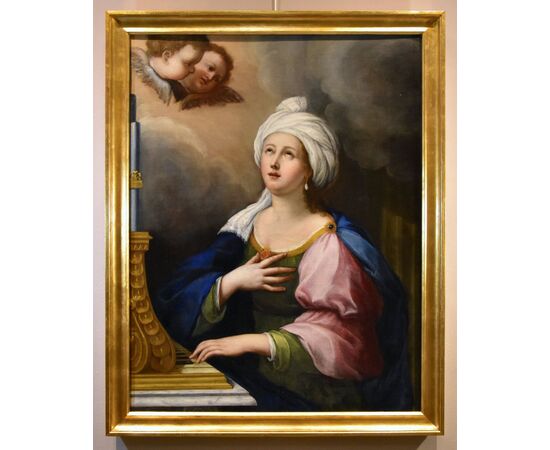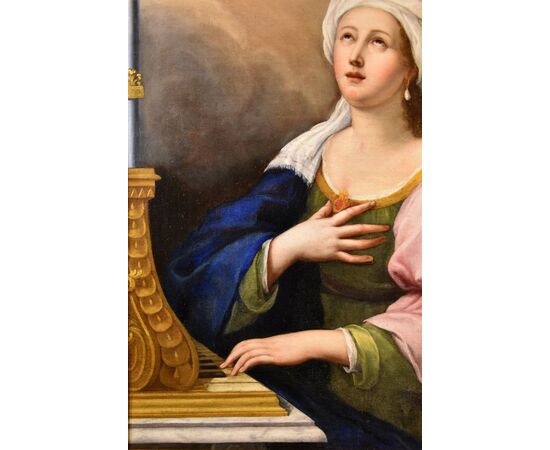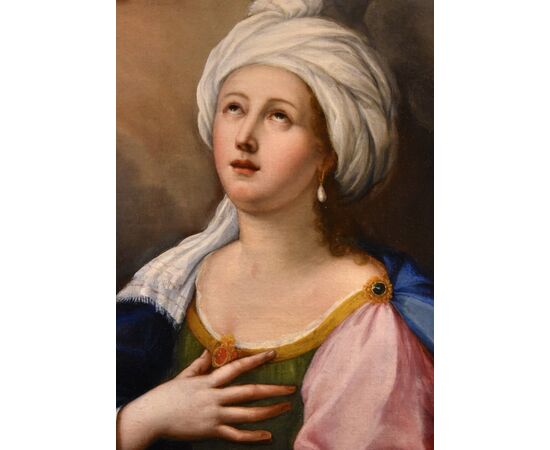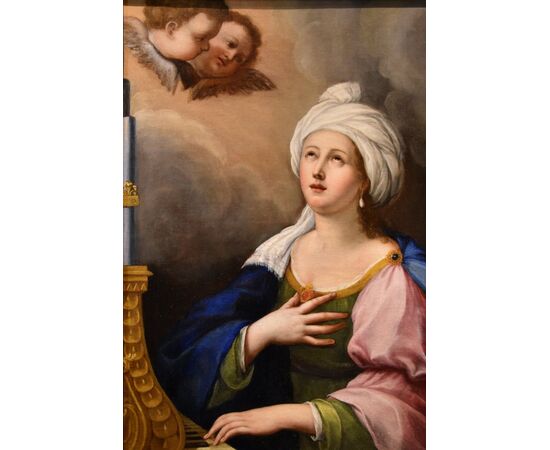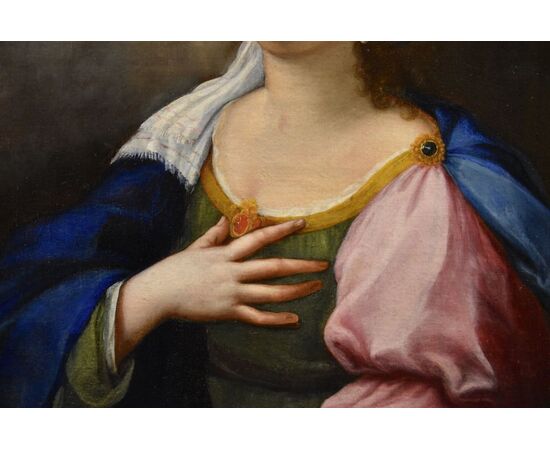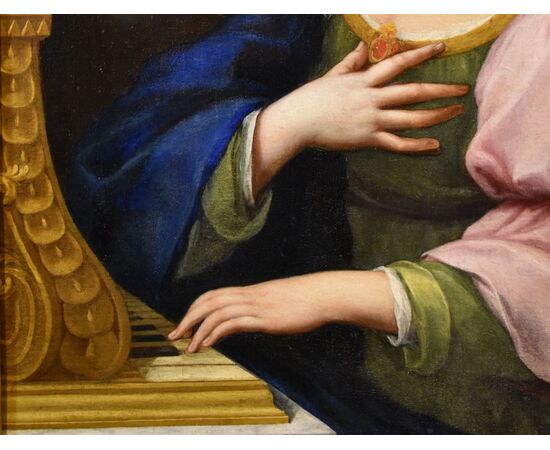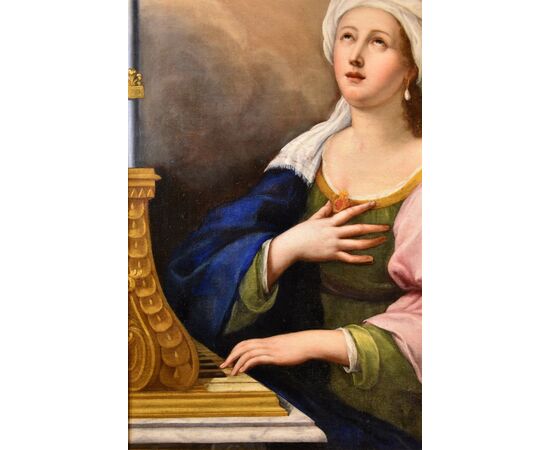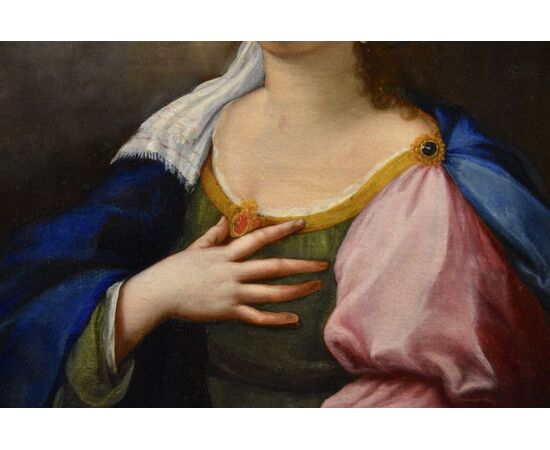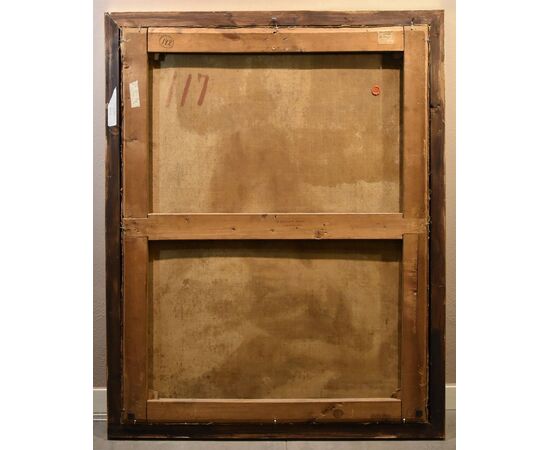Saint Cecilia and two cherubs, Lucas de la Haye, known as Luca Fiammingo (Nivelles, 1612–Rome, 1682)
Lucas de la Haye, known as Luca Fiammingo (Nivelles, 1612–Rome, 1682)
Saint Cecilia and two cherubs
Oil on canvas
118 x 91 cm. - Framed 129 x 102 cm.
Expertise by Prof. Emilio Negro (Bologna)
This evocative painting, which we are pleased to present to you, features Saint Cecilia at the center of the composition, the Roman noblewoman who later converted to Christianity and a highly esteemed figure in the Baroque period, as she is the patron saint of music, instrumentalists, and singers. She is depicted here as a splendid maiden dressed in regal attire, intent on playing a musical instrument, watched over by angelic presences.
The detail of her gaze directed upwards, irradiated by a mystical and divine light, is beautiful and evocative, since it is precisely through music that the Saint elevates herself towards the divine.
Regarding the stylistic elements, it should be noted that the painting in question belongs to a talented master active in the full seventeenth century, and precisely, based on the use of warm and balanced colors to soften the chiaroscuro contrasts, of Tuscan or Roman origin.
The skilled author should therefore be sought within the Central Italian Baroque culture influenced by the decorative splendor of the great Giovanni Battista Gaulli, known as Baciccio, and equally by the classical reinterpretation of Raphael carried out in the first decades of the seventeenth century by the Bolognese Guido Reni first, and then in Rome by the talented Andrea Sacchi. The traits of some foreigners, always operating in Rome in the same period, should not be ignored, among these it is necessary to name the works of Simon Vouet.
This explains why both the educated Bolognese culture of Reni, Francesco Albani, and Domenichino and the more evolved Roman pictorial narration of the seventeenth century, derived from the knowledge of the best works of Pietro da Cortona, are perceived in our canvas: the tending warm colors of this St. Cecilia and two cherubs in fact anticipate the salon refinements that foreshadow the ultramontane rococo, that is, the artistic current À la page so loved by the cultured Roman aristocracy of the seventeenth century.
Dwelling on the compositional details, it is easy to recognize in the painting the modus pingendi of the talented Lucas de la Haye, known as Fra Luca Fiammingo (Nivelles, 1612- Rome, 1682), a master with refined qualities active in Italy during the seventeenth century.
Being a Carmelite friar, his works were highly requested by his order, as well as by noblemen and wealthy merchants of the time;
As proof of the attribution proposed here, it will therefore be sufficient to compare our canvas with other works by Lucas de la Haye, such as the Assumption of the Virgin (1) and especially the Vision of St. Teresa of Avila (2), both in Montecompatri (church of S. Silvestro) and the Christ crowned with thorns (3) (Convent of S. Maria della Scala) and again Santa Teresa d'Avila has the vision of the angel (4) (Church of S. Maria della Scala, Rome).
In the paintings listed here, like ours, the typical painting of the Flemish master, imaginative and classicist, obtained with warm colors and flashes of light, yet ready to welcome with casual naturalness also Roman and Emilian influences, emerges.
(1) https://catalogo.beniculturali.it/detail/HistoricOrArtisticProperty/1200236918
(2) https://catalogo.beniculturali.it/detail/HistoricOrArtisticProperty/12002369203
(3) https://catalogo.cultura.gov.it/detail/HistoricOrArtisticProperty/12005154304
(4) https://catalogo.beniculturali.it/detail/HistoricOrArtisticProperty/1200225041
ADDITIONAL INFORMATION:
The work is completed by a pleasant gilded frame and is sold with a certificate of authenticity and guarantee.
We take care of and organize the transport of purchased works, both for Italy and abroad, through professional and insured carriers.
It is also possible to see the painting in the gallery in Riva del Garda, we will be happy to welcome you to show you our collection of works.
Contact us, without obligation, for any additional information.
Follow us also on:
INSTAGRAM https://www.instagram.com/galleriacastelbarco/?hl=it
FACEBOOK https://www.facebook.com/galleriacastelbarco/


